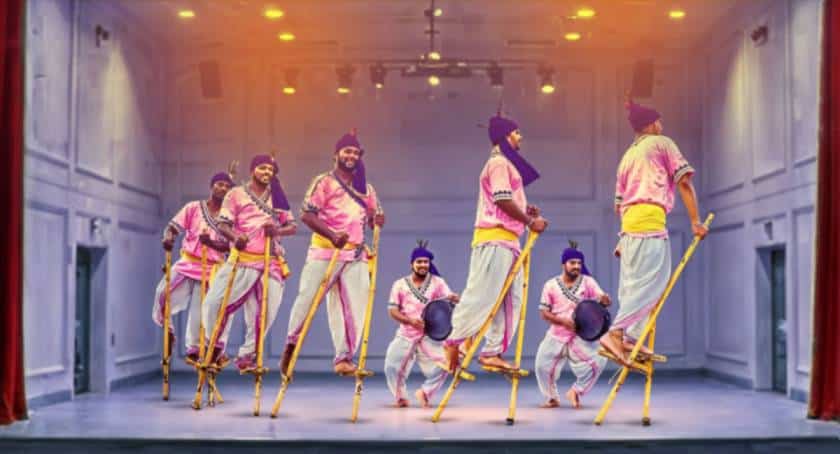Ranappa Dance: Folk Dances of India
Odisha, a land of vibrant traditions and rich cultural heritage is home to various forms of folk and classical dances. These dances are deeply interwoven with the region’s social and religious fabric, reflecting the people’s devotion and artistic expressions. Among Odisha’s numerous traditional dance forms, the Ranappa Dance is a distinctive and captivating performance that blends spirituality, devotion, and creative mastery. Rooted in ancient traditions, dedicated artists perform this dance form as a visual spectacle and a deep spiritual practice, expressing their devotion through movement.
Historical Roots and Evolution of Ranappa Dance
The Ranappa Dance originated in the rural villages of Odisha, where performers primarily offered it to deities during religious festivals and temple celebrations. This dance form is deeply associated with the worship of Lord Krishna and Lord Jagannath, two of the most revered deities in the state of Odisha. The connection to temple rituals and spiritual devotion makes the Ranappa Dance integral to Odisha’s cultural and religious life.
People believe that Ranappa dance has evolved, integrating elements of devotion, storytelling, and folk traditions. In its earlier incarnations, dancers entertained and educated audiences by performing devotional dances and telling mythological stories. The performances brought to life the everyday lives of rural communities, realistically depicted Lord Krishna’s holy plays (Krishna Leela), and highlighted Lord Jagannath’s wonders. Over time, the dance gained widespread recognition and became crucial to temple festivals, village celebrations, and state and national cultural events.
Distinctive Performance Styles and Techniques
What makes Ranappa Dance extraordinary is its distinctive performance style and technical complexity. The most striking feature is the use of wooden stilts, known as ‘Ranappa’ in the local language. Dancers strap these stilts to their legs, elevating themselves above the ground while performing complex movements with remarkable precision and grace. This requires immense skill, balance, and coordination, making the dance an actual test of agility and endurance.
Key Performance Elements:
- Use of Stilts: Dancers perform on wooden stilts, often several feet high, which adds spectacle and challenge to the performance.
- Graceful Movements: Despite the difficulty of balancing on stilts, the dancers execute smooth, synchronized, and aesthetically pleasing movements.
- Expressive Gestures: The dance incorporates intricate hand gestures (mudras) and emotive facial expressions (bhavas) to convey emotions and tell stories.
- Musical Accompaniment: Traditional Odia instruments, such as the mandala (a type of drum), harmonium, and cymbals, provide rhythmic support and enhance the performance’s vibrancy.
- Rhythmic Footwork: The dancers create rhythmic patterns using their feet while balancing stilts, making the performance visually and aurally engaging.
Combining these elements makes Ranappa Dance a mesmerizing art form that demands exceptional stamina, discipline, and dedication from the performers.
Key Costume Features
The attire worn by Ranappa dancers reflects Odisha’s rich cultural aesthetics. Designers create the costumes to be visually appealing and practical, allowing unrestricted movement while maintaining the traditional essence of the performance.
Key Elements of Ranappa Dance Costumes:
- Vibrant Dhotis or Sarees: Male dancers typically wear brightly colored dhotis, while female performers don traditional sarees, ensuring both comfort and cultural authenticity.
- Ornate Jewelry and Headgear: The dancers adorn themselves with traditional jewelry, including necklaces, bangles, and headpieces, adding to the grandeur of the performance.
- Decorated Stilts: The wooden stilts are often painted or embellished with artistic motifs, enhancing their visual appeal.
- Face Paint and Makeup: Performers use expressive makeup to highlight their facial features, ensuring their expressions are visible even from a distance.
The costumes and accessories enhance the dance’s aesthetics and contribute to its storytelling, connecting it with the performances on a deeper level.
Themes and Cultural Significance
Ranappa dance is a potent storytelling medium that transmits folktales, mythological stories, and spiritual teachings. It is more than just a demonstration of talent. The performers often center their acts around the following themes:
- Devotion to Lord Jagannath: Many performances depict Storieine’s presence and teachings.
- Krishna Leela: Episodes from Lord Krishna’s early life, including his victories over demons and humorous encounters with the Gopis (cowherd maidens), are featured in this series.
- Village Life and Traditions: Some performances highlight the simplicity and beauty of rural life, showcasing agriculture, folk customs, and community values.
- Spiritual Offering: People often consider the dance a sacred offering to the gods, making it an act of devotion and entertainment.
The spiritual essence of the Ranappa Dance makes it a revered tradition. It fosters a deep connection between performers, audiences, and the divine.
Where is Ranappa Dance Performed?
Dancers primarily perform the Ranappa Dance during festivals, temple rituals, and cultural events across Odisha. Some of the notable occasions include:
- Rath Yatra: The Rath Yatra, the grand chariot festival of Lord Jagannath at Puri, is one of Odisha’s most important religious events.
- Dola Purnima: A celebration characterized by colorful processions and dance performances honoring the heavenly love of Radha and Krishna.
- Village Fairs and Melas: These regional celebrations give folk performers a stage to display their skills and preserve traditional dance styles.
- Government-Sponsored Cultural Programs: Organizations such as the Odisha Sangeet Natak Akademi promote folk arts nationally and internationally, helping Ranappa Dance gain wider recognition.
Final Thoughts
Ranappa Dance is living evidence of Odisha’s rich cultural tapestry. Its blend of devotion, skill, and artistic expression makes it a genuinely mesmerizing spectacle that continues to captivate audiences. This distinctive dancing style proudly represents Odisha’s rich history, and artists and cultural organizations actively work to preserve and promote it.
Ranappa Dance can inspire new generations and ensure its heritage lives on for many years by raising awareness, educating people, and fostering respect. As further venues for showcasing this fantastic custom arise, our shared duty is to honor and protect the cultural treasures that characterize our history.


